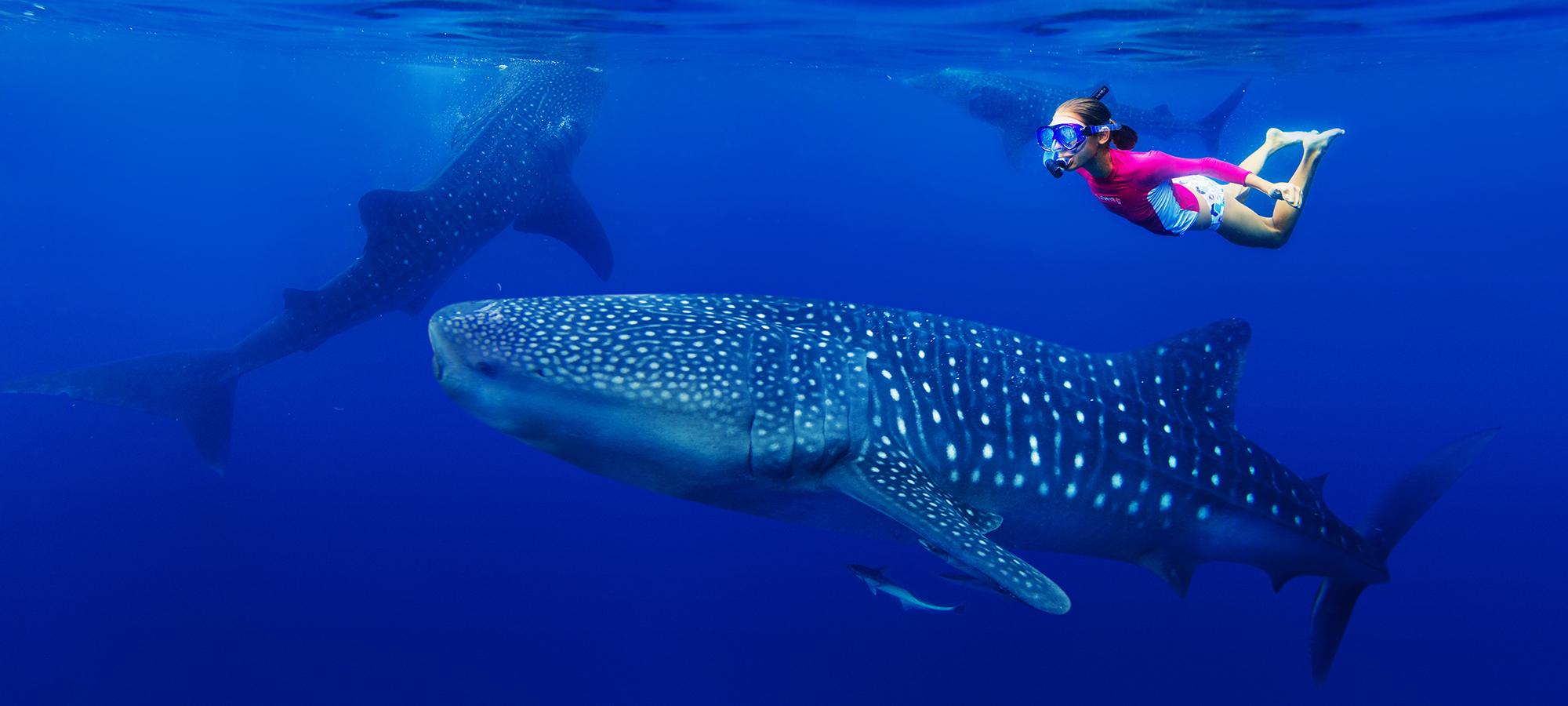How to Swim with Whale Sharks in Isla Mujeres, Mexico
The captain tells us to get ready, so we clambered onto the side of the boat: perched on the edge, our fins hang toward the water, mask and snorkels on. Just in front of our boat are snorkelers swimming fast. There must be a whale shark below.
As our boat passed the snorkelers, the captain gave us the signal. Trying to contain our excitement, we drop down as gracefully as possible, minimizing noise and splash. We don’t want to disturb the gentle giant below.
The hulking cartilage body of a whale shark is, on average, about 40 feet, with the largest on record clocking in at 61 feet! Despite its intimidating size, this shark is are entirely harmless to humans. They filter feed, like baleen whales, eating minute sea life like plankton, which is likely what led to their (mis)naming.
I’ve come to the Mexico to witness the whale shark’s seasonal congregation off Isla Mujeres, where many as 400 have been seen at one time. From June and September boats packed with snorkelers leave the island, as well as Cancun and Isla Holbox, and travel about an hour to an open ocean area where the whale sharks commonly feed. Nothing in the ocean is ever guaranteed, but most days visitors see at least a few whale sharks and some days they see dozens.
Even though so many are seen in this area each summer, whale sharks are endangered. Their populations are declining in the face of threats like shark finning, entanglement in fishing gear and pollution, ingestion of pollution like plastics, being struck by boat propellors or ships, and habitat loss from climate change.
As I slipped below the waves, I could only see water in all directions. Then, suddenly, there was movement in the blue. A shadow grew bigger and bigger, coming straight for us. The bus-sized animal emerged just as I prepared to both get out of its way and swim next to it as fast as I could.
The whale shark barely appeared to be moving, but one second we were looking at its head and the next I was staring at its broad midsection. Kicking for all I was worth, I kept up for a little bit, admiring the white spots and feeling small next to such a huge animal. Eventually, out of breath, I let it slide a bit further away, though still in sight — not a difficult feat when the creature you’re tailing is about the size of a semitrailer.
It amazes me how little we know about these gentle giants. There are certain places they congregate seasonal, such as Isla Mujeres, but where do they go after that? Their migration patterns are a mystery. One tagged individual travelled more than 8,000 miles in a year. Do they all move so much? It is unknown where they mate, give birth or where juveniles are raised. We don’t know how long they live either, though studies using growth rings on their vertebrae (like tree rings) suggest they can live at least 50 years, possibly beyond 100.
The whale shark’s massive tail — taller than me — begins to move away from me in the water. I swam on, trailing close. Suddenly, with just a slight flick of its tail, the world’s largest fish disappeared back into the blue.
Sticking our heads out of the water and cheering in excitement, the boat swings around to pick us up. We wait our turn as the other boats give their passengers a chance. Luckily, our captain soon spots another whale shark and slowly approaches from the front.
Unlike the last, this fellow wasn’t in a hurry. As we slip off the boat, it opens it giant mouth to take in a gulp of sea water (hopefully filled with delicious microorganisms). For a few minutes we hardly had to swim. It just floats with us, rhythmically opening and closing its mouth and its gills.
To be face to face with this giant but elusive ocean creature was amazing. We were lucky to get two long encounters, but it wasn’t enough. I wanted to spend even more time with them. Luckily, we already had a second day booked.
Need to Know
When to Go
June through September.
Conditions
Temperatures are warm all around this time of year, with water around 80 to 82°F and topside around 84°F.
Getting There
Isla Mujeres is a 20-to-30-minute ferry ride from Cancun, boats depart throughout the day. It is also possible to take a very short flight. Getting to the whale sharks is about an hour boat ride depending on sea conditions and boat speed. Boats also depart from Cancun or Isla Holbox.
Rules
There are strictly-enforced regulations for this encounter to keep whale sharks safe among a tourist influx. Two travelers and their guide maximum can be in the water at one time from each boat, which is capped at 10 passengers; only snorkeling — not scuba diving — is allowed; you cannot touch the whale sharks; use of lights and strobes are banned; sunscreen must be reef-safe.
Equipment
Mask, snorkel, fins and a 3mm shorty. Life jackets are mandatory except on free diving charters with certified free divers. Most charters provide mask, snorkels, fins and lifejackets.











